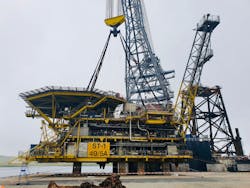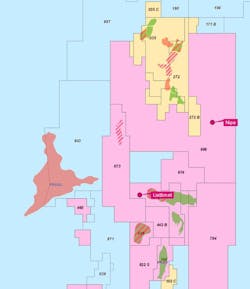Markham platform reaches Shetland
Among the ongoing removal programs, the Dales Voe decommissioning site in Shetland has received Spirit Energy’s ST-1 gas production platform from the Greater Markham Area of the southern North Sea. The facility had been in warm suspension mode since September 2017: the heavy-lift vessel Seaway Strashnov removed the steel jacket and topsides, weighing a total of 2,500 metric tons (2,756 tons), in two single lifts.
In the same region, DNO has contracted Well-Safe Solutions to decommission up to 21 wells on the Schooner and Ketch gas fields, while Perenco is seeking approval to decommission the normally unmanned Pickerill Alpha and Bravo platforms. The Pickerill gas field ceased production last summer, 25 years after start-up.
Decommissioning initiatives paying off
Decommissioning costs are falling across the UK continental shelf as industry-wide initiatives start to take effect. Nils Cohrs, Head of Decommissioning at the Oil and Gas Authority (OGA), said his department had revised its forecast for remaining expenditure on UK fields to £56 billion ($70 billion), down from £59.7 billion ($74.6 billion) in 2017. And the signs are that the projected overall cost could fall faster this year to £49 billion ($61.3 billion), putting the industry on track to reach the OGA’s target of £39 billion ($48.8 billion) in 2022.
Cohrs, who was speaking at an event in London organized by Oil & Gas UK, cautioned that the figures cannot be set in stone because the industry is also adding new assets, thanks to drilling successes west of Shetland and in the central North Sea. “We are also mindful of the risk,” he said, “as this is the lowest time for the industry in terms of costs – and these are [showing signs of] going up. But at the same time, more and more specialists in the supply chain are taking on the challenge of decommissioning, so hopefully this will mitigate some of the risk.”
So where are the cost reductions coming from? In 2018, the UK sector spent £1.4 billion ($1.75 billion) on decommissioning – £400 million ($500 million) lower than the forecast figure – with 90% of the cuts coming from savings on projects and only 10% due to projects being deferred. The main focus of attention has been on four key areas, Cohrs said: well P&A, removal of subsea infrastructure, topsides and jackets, and post-cessation of production costs. Due to the higher oil price and lower costs, oil companies throughout the sector are taking the opportunity to do things earlier, he added.
The OGA is also looking to alter mindsets by using its insights to provide operators with benchmarks. “We tell an operator, your well P&A operations cost four times more than those of your peer group in the North Sea. They might say, ‘our wells are more complex,’ but we encourage them to examine what others have done. In certain cases, after looking at our dashboards, they have come back six months later and admitted that they could be doing things cheaper. We are also trying to influence operators to think of decommissioning at least six years before it actually starts.”
Equinor taking charge of Wisting
Equinor and OMV plan to collaborate on two Norwegian offshore projects. One is the Wisting oil development in the southern Barents Sea where estimated recoverable resources are 440 MMbbl, based on the six wells drilled to date. Although OMV discovered the field, Equinor would be development operator with OMV staff taking lead roles in subsurface work, drilling operations, and other activities. Formal transfer of operatorship should go through this summer. Studies to date have focused on an FPSO with either a circular or ship-shaped hull, connected to a subsea production system comprising 19 production and 15 water injection wells.
The other project is Hades/Iris, discovered last year on the Haltenbanken in the Norwegian Sea and thought to hold 40-245 MMboe recoverable. In this case, OMV would remain operator but would work with Equinor on optimization studies and a tie-in to existing offshore infrastructure.
Elsewhere in this region, Equinor started production last month from the 76-MMboe Trestakk field via a five-well subsea tieback to the Åsgard A floating production vessel. Final costs were a projected NOK500 million ($58 million) lower than the NOK5.5 billion ($641 million) budgeted at sanction in 2017.
Liatårnet boosts NOAKA project
Aker BP has discovered Norway’s largest new oil and gas field of what to date has been a thin year for exploration in the sector. The few other successes had been modest, near-field accumulations, but Liatårnet in North Sea license PL 442 could hold up to 200 MMboe. The structure is within Aker BP’s proposed North of Alvheim and Krafla-Askja (NOAKA) development area, also encompassing seven other discoveries. Thanks to Liåtarnet, the gross resource has risen to around 700 MMboe, making this potentially one of Norway’s largest remaining offshore projects.
The company and partners in other licensees have reviewed various potential concepts, with Aker BP’s preference being a new hub platform in the central part of the area with capacity to tie in future finds in the area. •




